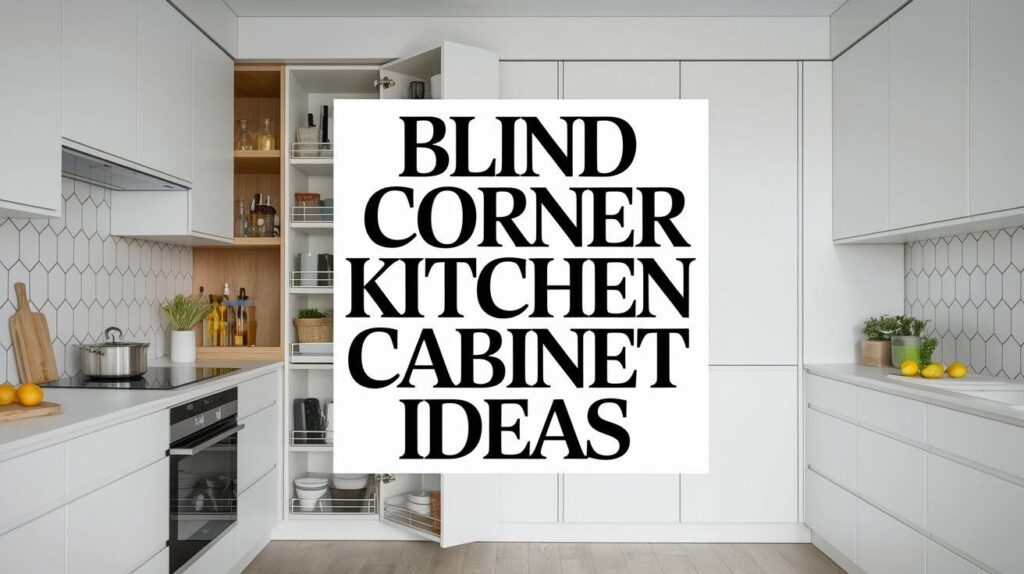Kitchen corners create storage headaches for homeowners everywhere. You open a cabinet door and half the space sits unreachable in the back. Items disappear into dark corners, never to be seen again.
Blind corner cabinets represent one solution to this common problem. But many people don’t understand what they are or how they work. The name sounds confusing, and the design seems complicated.
This article breaks down everything about blind corner kitchen cabinets. You’ll learn exactly what they are and how they differ from regular corner cabinets. We’ll explain why corners cause design challenges in the first place.
By the end, you’ll understand your corner cabinet options completely. You’ll know if blind corner cabinets fit your kitchen layout and storage needs. Let’s clear up the confusion and help you make the right choice.
Why You Need to Maximize Blind Corner Space
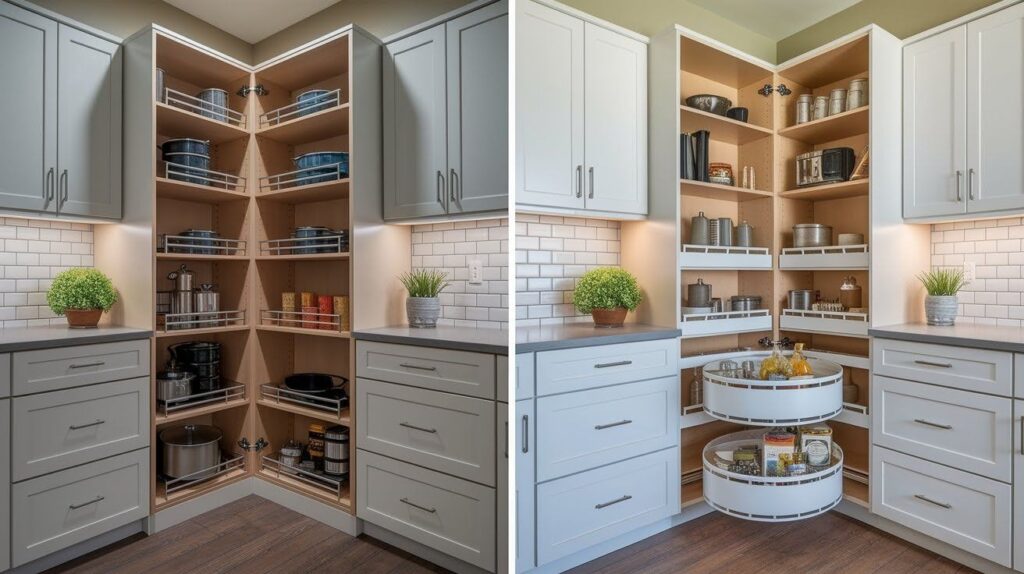
Maximize kitchen efficiency by investing in smart blind corner storage solutions that improve accessibility, prevent clutter, and suit your budget and space needs.
Efficient Use of Kitchen Storage
Kitchen storage space costs serious money. Every square inch you waste means less room for your dishes, pots, and pantry items. Blind corners often become dead zones where storage goes to die.
Most kitchens lose 50% of their corner storage to poor design. Items get shoved into the back and forgotten. You buy duplicates because you can’t find what you already own. This wastes both space and money.
Smart blind corner solutions change everything. They bring hidden items into easy reach. You can actually use the full depth of your corner cabinets. No more crawling on hands and knees to find that missing mixing bowl.
Common Issues with Blind Corners
Traditional corner cabinets create multiple problems that drive homeowners crazy. The issues go beyond just wasted space.
Accessibility tops the list of complaints. You need to remove everything in front just to reach items in the back. This makes cooking more complicated than it should be. Simple meal prep becomes a treasure hunt.
Items get lost and forgotten easily. That expensive stand mixer disappears behind everyday dishes. Spices expire because you can’t see them. Small appliances gather dust in unreachable corners.
Budget Considerations in Choosing Blind Corner Cabinet Types
Blind corner solutions range from budget-friendly fixes to high-end installations. Your choice depends on your needs and wallet.
Basic lazy Susans cost the least but have limitations. They work well for lightweight items like dishes and canned goods. However, they waste vertical space and can’t handle heavy pots and pans effectively.
Pull-out drawer systems cost more but offer better functionality. They bring everything into full view and easy reach. Installation requires more cabinet modifications, which increases labor costs.
Smart Blind Corner Cabinet Ideas for Base Cabinets
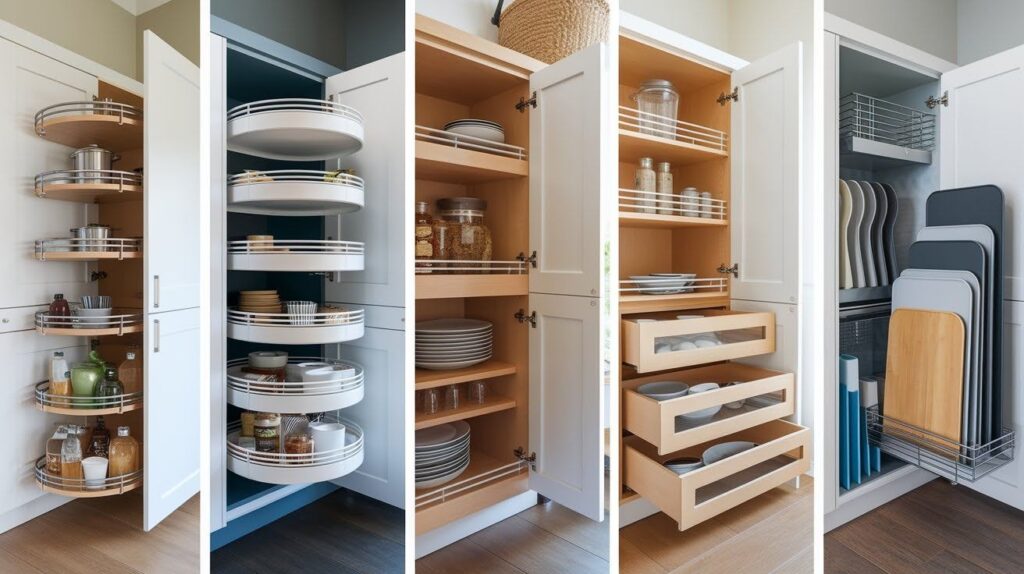
Use smart corner cabinet solutions: like pull-out systems, Lazy Susans, L-shaped drawers, sliding shelves, and vertical organizers to maximize storage, accessibility, and efficiency in blind corners.
1. Blind Corner Cabinet Pull-Out Systems
Pull-out systems transform your blind corner from a black hole into accessible storage. These mechanisms bring everything stored in the back corner right to your fingertips.
The system works through connected shelves that pull out in sequence. Open the cabinet door and pull the front shelf forward. The back shelf automatically follows, carrying items from the deepest corner into easy reach.
Rev-A-Shelf makes some of the most popular versions. Their systems include multiple shelf levels and can handle surprising amounts of weight. Installation requires some cabinet modifications but delivers dramatic improvements in functionality.
2. Lazy Susan Cabinets
Lazy Susans represent the classic corner cabinet solution. Most homeowners recognize these rotating platforms that spin to bring items within reach.
Half-moon versions fit against one cabinet wall, leaving space for the door mechanism. Kidney-shaped platforms work around cabinet doors and maximize usable surface area. Full-circle versions offer the most storage but require wider cabinet openings.
These work best for lightweight items like dishes, canned goods, and small appliances. The rotating action makes everything visible and accessible with a simple spin.
3. Corner Drawers
Custom L-shaped drawers maximize corner storage while maintaining clean lines. These specially designed drawers follow the cabinet’s corner shape perfectly.
The L-shape allows drawers to extend into both cabinet sections. This creates more usable storage than traditional rectangular drawers. Everything stays visible and within easy reach.
These drawers look great and function smoothly when properly designed. The custom fit means no wasted space around the storage area. Soft-close mechanisms add a premium feel to daily use.
4. Sliding Drawers & Shelving Systems
Multi-level sliding systems create organized storage throughout your corner cabinet. Different shelf levels slide out independently, giving you access to specific items without disturbing others.
These systems work like filing cabinets for your kitchen. Pull out the shelf level you need while others stay in place. Multiple levels multiply your storage capacity vertically.
The benefits include excellent visibility of stored items and easy access to deep storage areas. You can organize by frequency of use or item type. Everything stays neat and findable.
5. Pan and Tray Organizers
Vertical organizers turn narrow corner spaces into efficient storage for flat items. These systems hold items upright like books on a shelf.
The upright storage method maximizes space in cabinets with limited width but good height. Baking sheets, cutting boards, and pot lids store efficiently without stacking.
Install dividers or slots to keep items separated and prevent sliding. Some systems include adjustable dividers that accommodate different item sizes.
Blind Corner Cabinet Ideas for Upper Cabinets
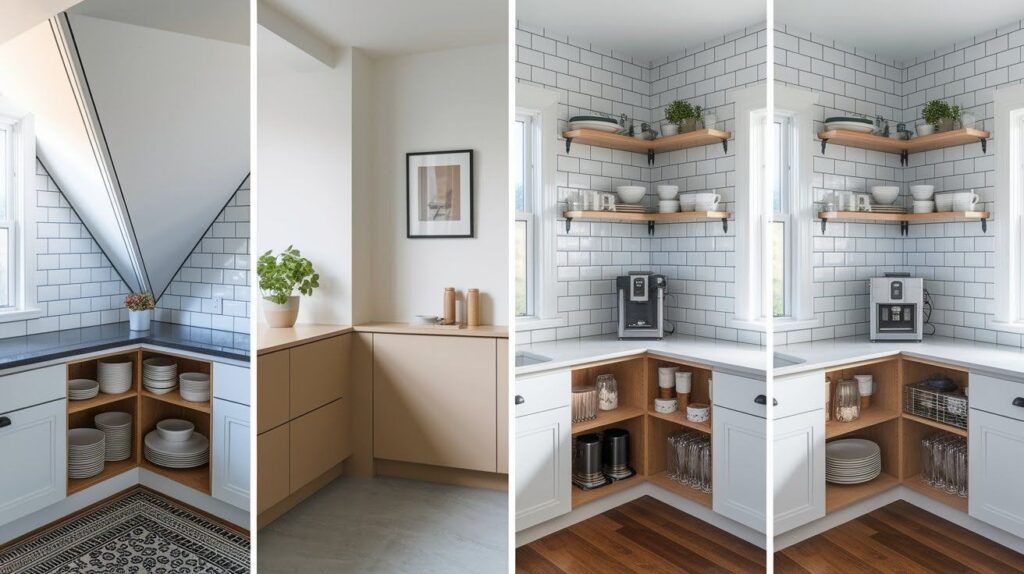
Explore alternative corner cabinet solutions like diagonal cabinets, skipping corner storage, open shelving, or countertop units to improve accessibility, style, and layout flexibility in your kitchen design.
1. Diagonal Corner Cabinets
Diagonal corner cabinets cut across the corner at a 45-degree angle. This traditional approach connects two cabinet runs while providing accessible storage space.
Many people consider this design outdated compared to modern alternatives. The angled front can look awkward in contemporary kitchens. The shape also wastes some corner space behind the diagonal.
The main advantage is easy access compared to blind corners. Everything inside stays visible and reachable. Installation costs less than complex corner mechanisms.
2. Cabinets on One Wall Only
This approach skips corner cabinets entirely by stopping cabinets on one wall. The adjacent wall remains empty or uses different storage solutions.
The streamlined look appeals to modern design preferences. You avoid corner complications while creating clean, uninterrupted lines. This works especially well in smaller kitchens where corner cabinets might feel overwhelming.
Minimizing cabinet bulk opens up the kitchen visually. The empty wall space can showcase artwork, windows, or architectural features. You gain flexibility in kitchen layout and traffic flow.
3. Open Shelving in the Corner
Open corner shelving creates display space while maintaining functionality. These shelves work well for items you use frequently or want to show off.
The decorative aspect lets you personalize your kitchen with attractive dishes, plants, or cookbooks. Everything stays visible and easily accessible. The open design makes kitchens feel larger and less closed-in.
Functional benefits include easy loading and unloading. No doors to open or close. Quick access to everyday items like coffee mugs or spices. Great ventilation for items that need air circulation.
4. Countertop Cabinets in the Corner
Countertop cabinets sit on top of your counter instead of hanging on the wall. This furniture-style approach creates a custom, built-in appearance.
The design works perfectly for appliance garages that hide coffee makers, toasters, or blenders. Roll-up doors or hinged panels conceal appliances while keeping them easily accessible. This solution maintains clean countertop lines.
Custom looks come from treating these cabinets like furniture pieces. Choose different finishes or hardware from your main cabinets. Add decorative details like crown molding or furniture legs. The contrast creates visual interest.
Creative Custom Solutions
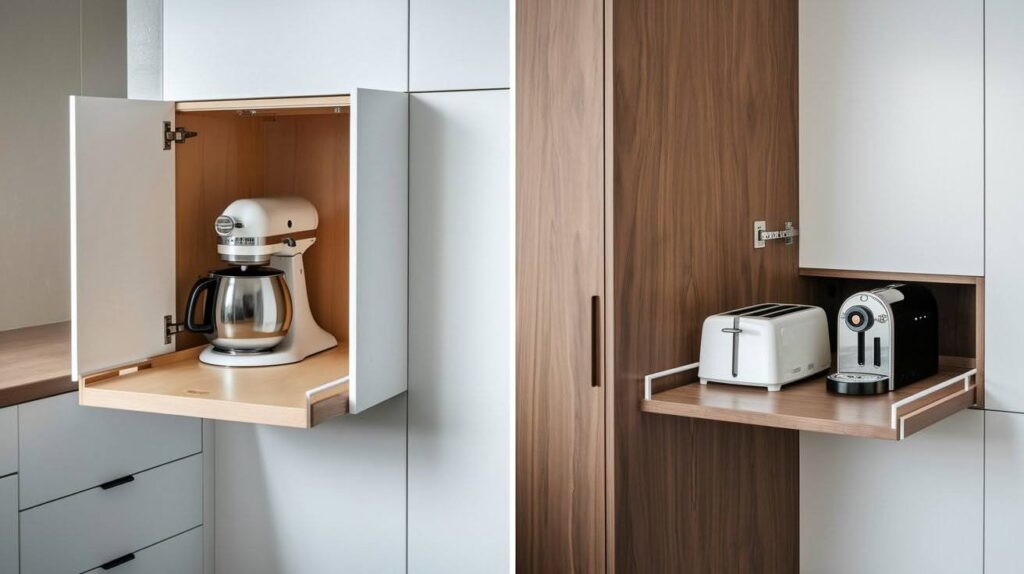
Creative corner solutions like appliance garages and sliding walnut boxes offer convenient, stylish ways to store small appliances while making practical use of otherwise wasted corner space.
1. Appliance Garage in the Corner
Corner appliance garages solve two problems at once. They hide small appliances while making dead corner space useful again.
The sliding shelf concept works like a cabinet drawer that extends toward you. Mount your coffee maker, blender, or stand mixer on the sliding platform. When you need the appliance, simply pull the shelf forward. Push it back when finished to keep counters clear.
This system keeps appliances plugged in and ready to use. No more hauling heavy mixers from cabinets to counters. The sliding action brings everything to comfortable working height automatically.
2. Walnut Box with Sliding Tray
A custom walnut box creates storage in just part of your corner space. This solution acknowledges that some corner areas will never be easily accessible.
The sliding tray system works within the wooden box. Pull out the tray to access your coffee maker or toaster. The smooth sliding action makes daily use effortless.
This approach uses dead space efficiently without trying to access every square inch. You gain functional storage while accepting that the deepest corner remains unused. Sometimes partial solutions work better than complex mechanisms.
Blind Corner Cabinet Tips
Plan smart by measuring carefully, assessing your needs and budget, then choose between affordable fixes like lazy Susans or premium solutions like pull-outs and corner drawers for maximum storage and functionality.
Planning and Assessment
- Measure your corner space carefully before selecting any storage solution
- Consider your cooking habits and what items you’ll store most often
- Factor in installation costs when budgeting for corner solutions
- Choose solutions based on the weight of items you plan to store
Budget-Friendly Solutions
- Start with lazy Susans for lightweight items like dishes and canned goods
- Use vertical organizers for baking sheets, cutting boards, and pot lids
- Install basic pull-out shelves for better access without major modifications
- Consider partial solutions that use accessible space efficiently
Maximum Functionality Options
- Install pull-out systems that bring deep storage into easy reach
- Choose corner drawers for heavy items and maximum space utilization
- Add sliding shelf systems for organized, multi-level storage
- Create appliance garages to hide small appliances while keeping them accessible
Conclusion
Blind corners don’t have to be storage nightmares. The right solution depends on your budget and specific needs.
Budget-friendly options like lazy Susans and vertical organizers solve basic access problems without major modifications. Mid-range pull-out systems and sliding shelves offer better functionality for serious cooks. Premium corner drawers and custom solutions maximize every inch while looking great.
Consider your cooking habits when choosing. Daily coffee makers benefit from appliance garages. Heavy pot collections need sturdy pull-out systems. Display items work well with open shelving.
Successful blind corner setups balance design with function. The best solution looks good in your kitchen while making daily cooking easier. Don’t let corner challenges limit your kitchen’s potential.
Start with your biggest frustration and choose the solution that addresses it directly. Your kitchen will work better for years to come.
Frequently Asked Questions
What is the difference between a blind corner cabinet and a regular corner cabinet?
A blind corner cabinet has one door that opens while the adjacent cabinet section remains hidden behind the cabinet frame. Regular corner cabinets typically have doors on both sides or use diagonal fronts that make all storage visible and accessible.
How much does it cost to install a blind corner cabinet solution?
Basic lazy Susan installations cost $100-300, while pull-out systems range from $200-600 depending on complexity. Custom corner drawers and premium solutions can cost $800-1500 including professional installation and any required cabinet modifications.
Can I install blind corner cabinet organizers myself?
Simple solutions like lazy Susans and vertical organizers are DIY-friendly with basic tools. Complex pull-out systems and corner drawers often require professional installation due to precise measurements, cabinet modifications, and specialized hardware mounting.
What items work best in blind corner cabinets?
Store lightweight, frequently used items in rotating systems and heavy pots in pull-out drawers. Keep baking sheets and cutting boards in vertical organizers, while small appliances work well in sliding shelf systems or appliance garages.
Are blind corner cabinets worth the extra cost?
Blind corner solutions pay off if you cook frequently and need maximum storage efficiency. They transform wasted space into functional storage, reduce frustration during cooking, and can increase your home’s value through improved kitchen functionality.

